The Ultimate Guide to Air Conditioning in Melbourne: Everything You Need to Know
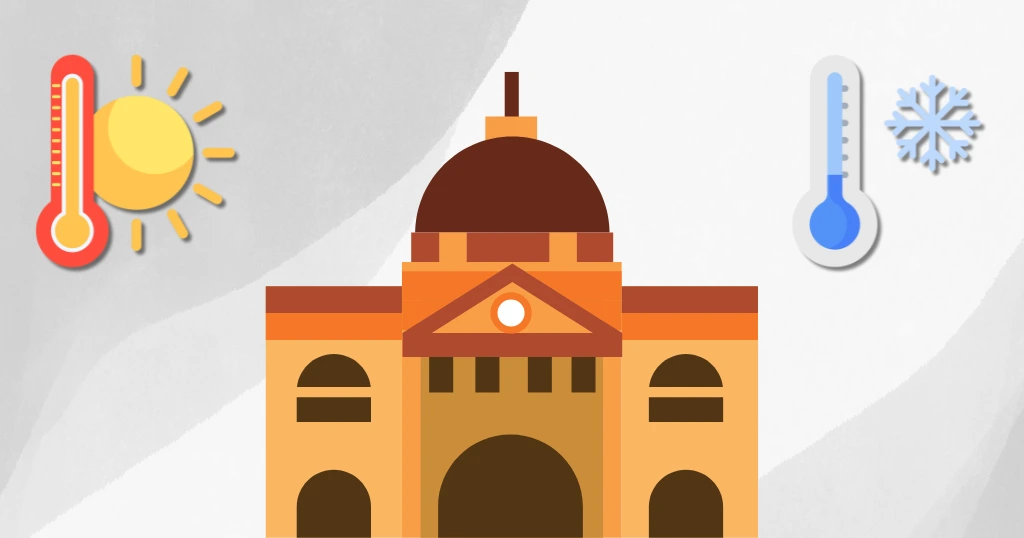
This is a super detailed guide on air conditioning in Melbourne.
In this ultimate guide, you’ll:
- Discover the best air conditioning systems for Melbourne’s climate.
- Learn how to maintain and troubleshoot your air conditioner
- Get energy-saving tips to reduce cooling costs
- Explore top air conditioning brands and installation advice tailored to Melbourne.
- Find solutions to common air conditioning problems and avoid costly repairs.
Let’s jump straight in!
Contents
- 1 Why Air Conditioning is Essential in Melbourne
- 2 Types Of Air Conditioning Systems
- 3 Choosing the Right Air Conditioner for Your Home
- 4 What to know about Air Conditioning Installation
- 5 Maintenance Tips
- 6 Common Air Conditioning Problems & How To Fix Them
- 7 Energy Efficiency and Cost-Saving Tips
- 8 Air Conditioning Brands Recommended for Melbourne
Why Air Conditioning is Essential in Melbourne
It seems as though every other conversation in Melbourne is about this.
Melbourne is known for its questionable weather changes.
So I will explain why you need air conditioning in Melbourne to stay cool.
Melbourne’s Unpredictable Climate
Many people wonder why Melbourne’s weather is so unpredictable.
And you wouldn’t be wrong to assume that.
But it comes down to the unique position of Melbourne in the grand scheme of things.
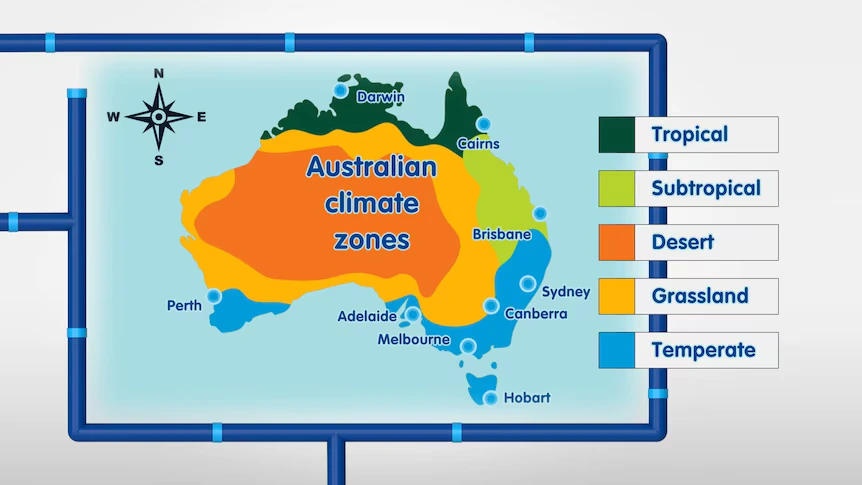
You’ll notice north of Melbourne there are hot deserts and hot semi-arid climates.
On the flip side in the south, you’ll see the Pacific Ocean and Southern Ocean.
This positions the city of Melbourne in a precarious middle point causing all types of weather fluctuations.
You wouldn’t go a summer in Melbourne without a few extremely hot days in the 40’s followed by a burst of showers and winds.
4 seasons in 1 day is nothing new for Melburnians and it has become a cultural aspect of life in southern Victoria.
With the ever-changing climate at the drop of a hat, you’ll need air conditioning to maintain a comfortable temperature all year round without hiccups.
Surviving Melbourne’s Summer Heat
Since the year 2000, we’ve seen Melbourne’s maximum summer temperature slightly creep up from the baseline, indicating the people need to prioritise keeping cool during summer.
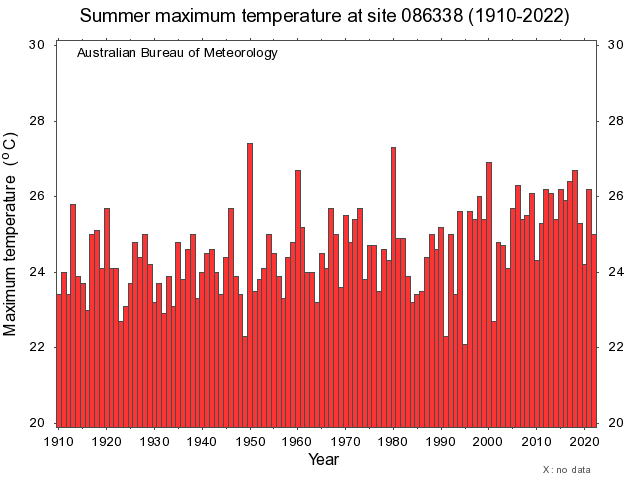 With January and February being Melbourne’s hottest and driest periods, you’ll likely face a heatwave for 1-3 days.
With January and February being Melbourne’s hottest and driest periods, you’ll likely face a heatwave for 1-3 days.
In December 2024 we saw a 40-degree day and multiple 35-degree-plus days.
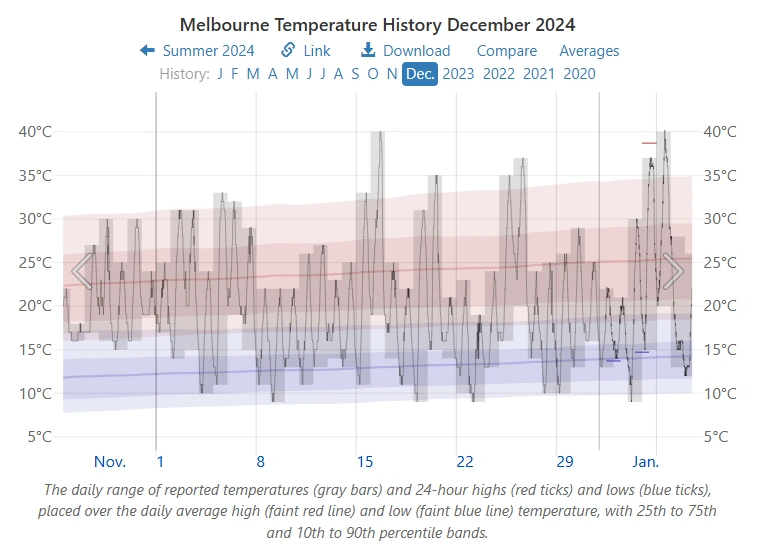 Whereas December 2023 didn’t record any temperatures above 35 degrees.
Whereas December 2023 didn’t record any temperatures above 35 degrees.
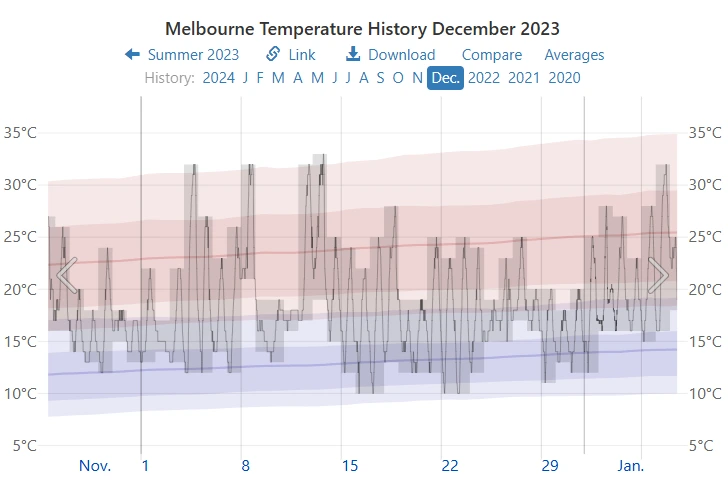 This may indicate that January and February 2025 could be hotter than usual.
This may indicate that January and February 2025 could be hotter than usual.
That said, you need a foolproof way to stay comfortable and cool moving forward.
Our 50 cooling tips to beat Melbourne’s summer will equip you with the tips, hacks, and best strategies to survive Melbourne’s brutal heat waves in 2025.
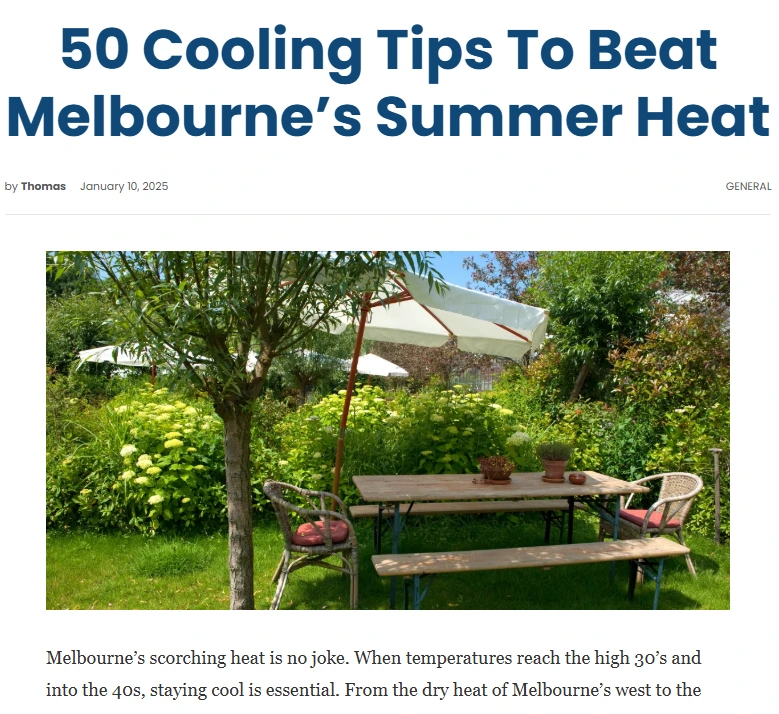 Setting an appropriate temperature level for your AC, installing draft stoppers for your doors, replacing certain light bulbs, and crafting a DIY mister fan are some of them.
Setting an appropriate temperature level for your AC, installing draft stoppers for your doors, replacing certain light bulbs, and crafting a DIY mister fan are some of them.
Health and Comfort Benefits
Health Benefits:
Prevention of Heat-Related Illnesses
During Victorian heat waves, there was an increase in mortality and morbidity.
The 2014 heatwave saw an estimated 167 excess deaths indicating that heat waves pose a significant risk to Melburnians.
The Victorian Department of Health recommends using air conditioning as their first tip to stay cool.
When the body heats up to an unhealthy level the following can occur:
- Worsening of existing health conditions
- Dehydration
- Heat exhaustion
- Heatstroke
- Heat cramps
- Heat rash
Improved Indoor Air Quality
According to the Australian Department of Health and Aged Care, indoor air can have higher concentrations of certain pollutants than outdoor air.
Some pollutants are fairly common, whereas others can be extremely hazardous and toxic for anyone.
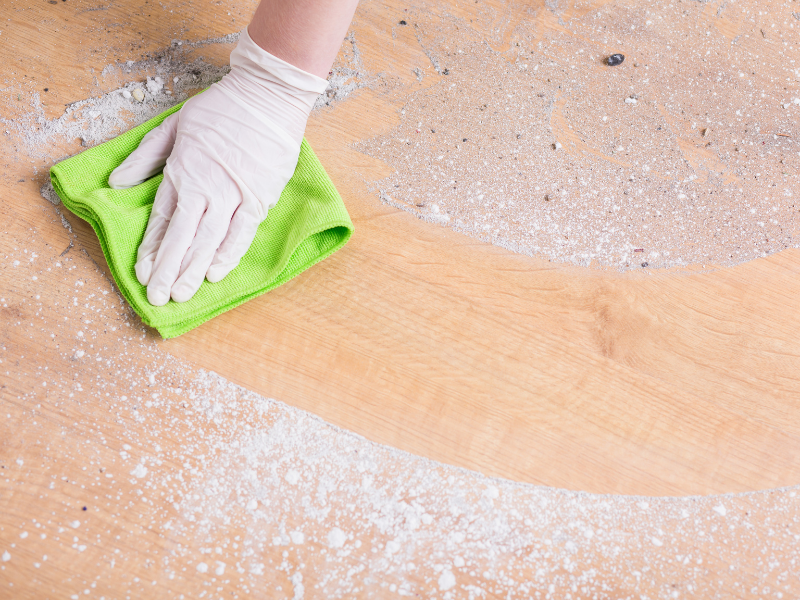
Air conditioning can help reduce airborne particles and pollutants by filtering the air. A test conducted by choice suggested that air purifiers have a positive effect on indoor air quality by filtering out smoke particles.
The main air pollutants in your home that you need to be wary of are:
- Dander and dust mites
- Mould
- Smoke, ash, and gases (carbon monoxide)
- Volatile organic compounds (VOCs)
- Lead
- Asbestos
Comfort Benefits:
Enhanced Sleep Quality
To ensure the best sleep, you need to optimise your internal body temperature.
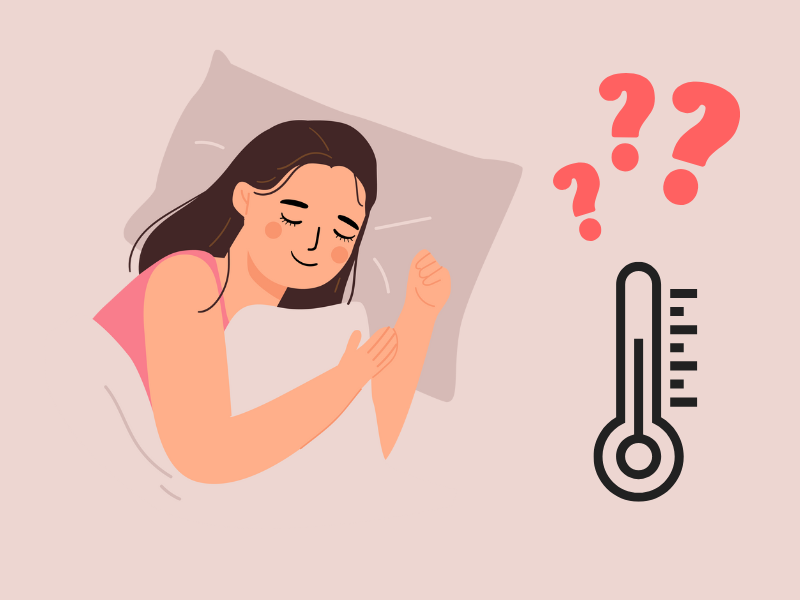
It can’t be understated how important sleep is to functioning well in your daily life.
Whether that’s being alert enough at work, recovering from physical exercise, or fighting off chronic illness, your body needs good sleep.
Healthline suggests an ideal room temperature of 15.6°C to 18.3°C.
You can achieve this through air conditioning, and setting your thermostat correctly before bed.
The ideal room sleeping temperature for dogs is between 10°C to 29°C.
So rest assured your pet will be safe!
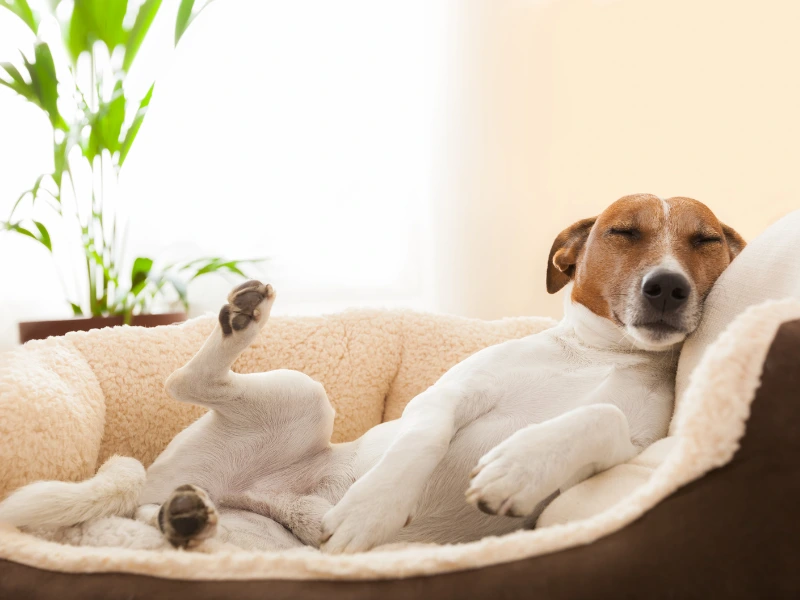
Mental Well-Being
When the temperatures rise in Melbourne, this can have a profound effect on your mood and stress levels.
You’ll know that when it gets ridiculously hot people can be more irritable, less friendly, and more argumentative.
If you’re able to control the temperature of your home, you can directly improve productivity through higher comfort levels, less physical strain on the body, and a stress-free mind.
To reduce stress it’s crucial to have a plan for these hot days.
A well-maintained air conditioner is the key to maintaining your wellbeing and ensuring a comfortable productive environment.
Types Of Air Conditioning Systems
You’ve figured out that Melbourne is almost unbearable without air conditioning, but what types of air conditioning systems are there and how do they work?
In this section, we’ll go over each modern air conditioning system available, their features, and what their strengths and weaknesses are for Melbourne homeowners.
Ducted Air Conditioning
How it works:
Ducted air conditioning supplies heating and cooling to your home, doing so via ducts that are connected to rooms (zones) within your home.

Pros:
- Complete cooling solution.
- Control rooms separately.
- Aesthetic, hidden design.
Cons:
- More costly to set up.
- Need space in the ceiling.
- Can need more upkeep.
Ideal use cases:
- Modern homes, looking for minimal design.
- Large homes, or multi-room homes.
Split System Air Conditioning
How it works:
Split systems work by having an indoor and outdoor unit, the indoor unit blows cool air into your desired space, while the outdoor unit extracts heat from the room.
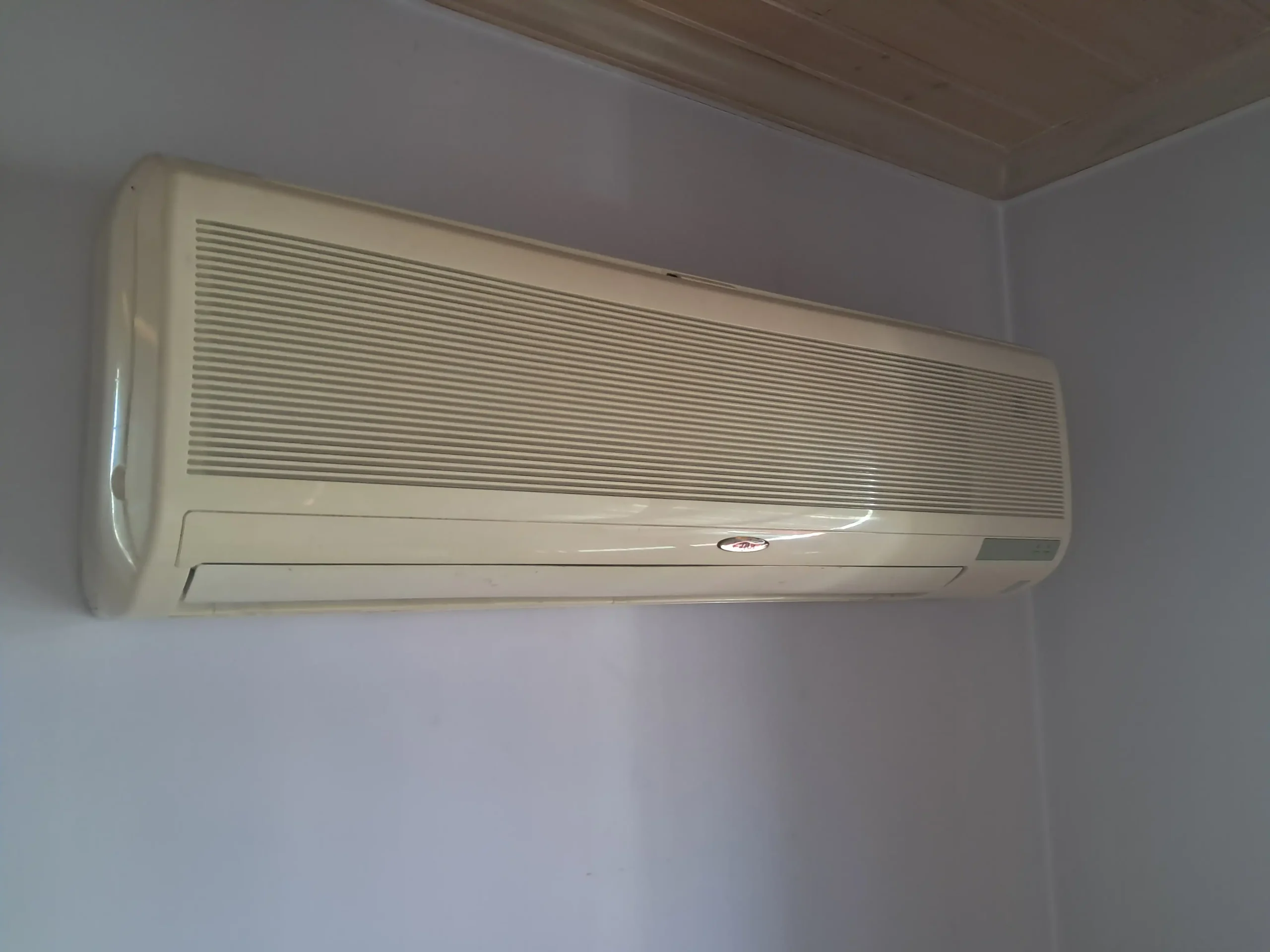
Pros:
- Cost-effective to install.
- Energy efficient.
- Hassle-free setup.
Cons:
- Only cools one room.
- Stick out from the wall.
Ideal use cases:
- Small homes, apartments.
Multi Split System
How it works:
Multi-split systems work the same way as standard split systems,, however, they have multiple indoor units that can distribute cool air to many more rooms.
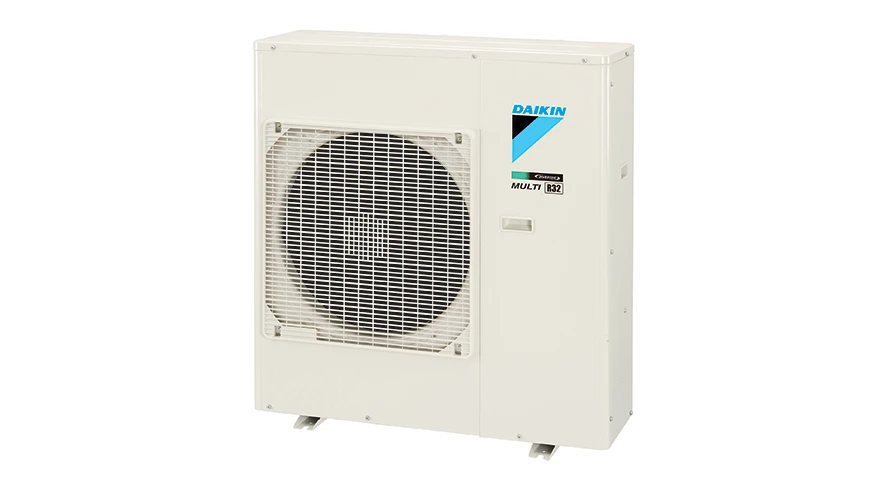 Pros:
Pros:
- Whole-home cooling.
- Don’t need separate outdoor units.
Cons:
- Can be costly if you get over 3 indoor units.
Ideal use cases:
- Homes with many rooms, or with not much space for outdoor units.
Evaporative Cooling
How it works:
Evaporative cooling works by air traveling over water-soaked pads causing a natural breeze throughout the home.
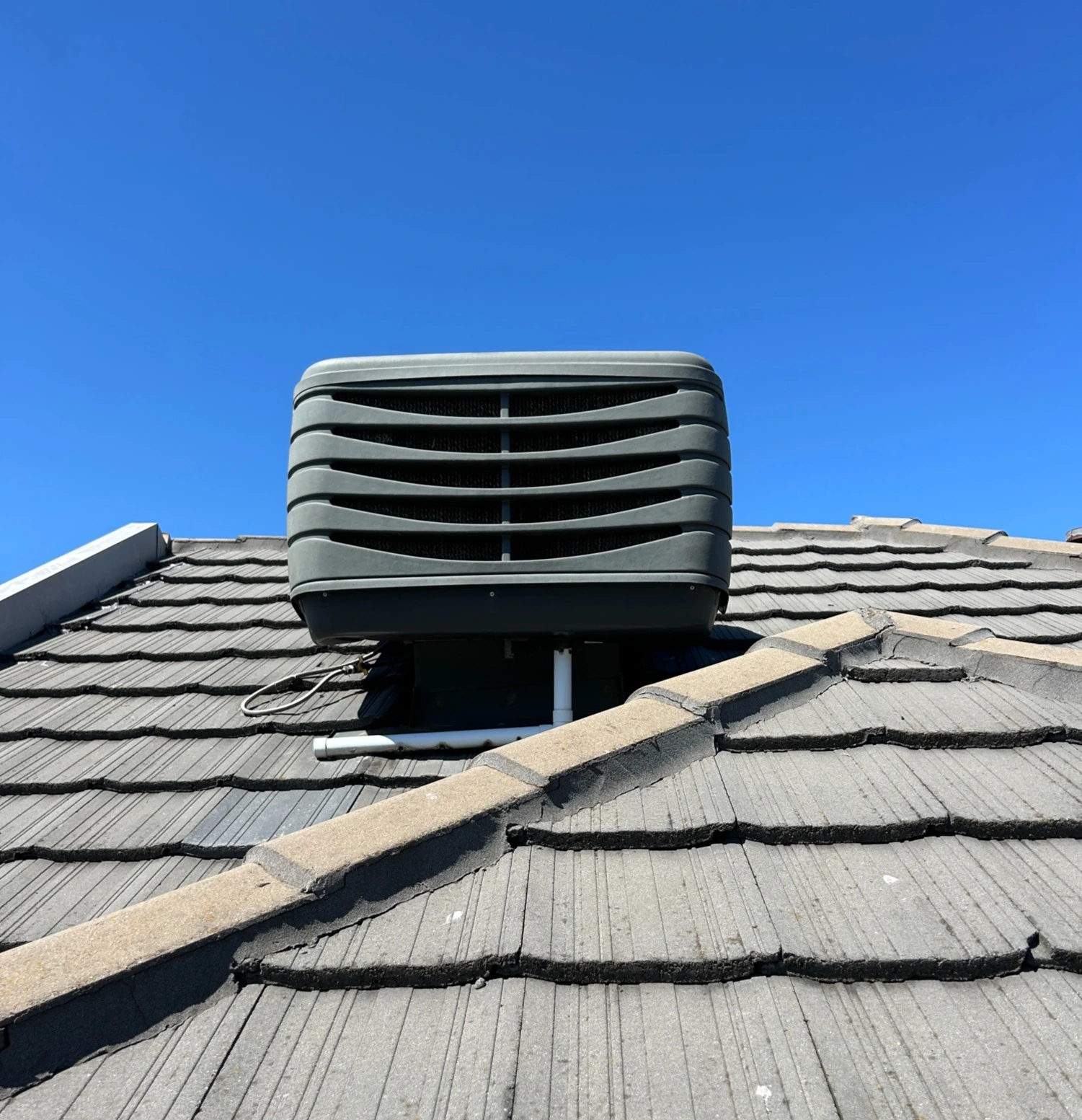
Pros:
- Improved indoor air quality.
- Eco-friendly air conditioning.
Cons:
- Loses effectiveness in high humidity.
- Need to have the door or window open.
Ideal use cases:
- Homes located in hot and dry climates.
- Homes with people that have allergies.
Add-On Cooling
How it works:
Add-on cooling works by connecting a refrigerated cooling unit to your existing gas ducted heating system using the same ducts.
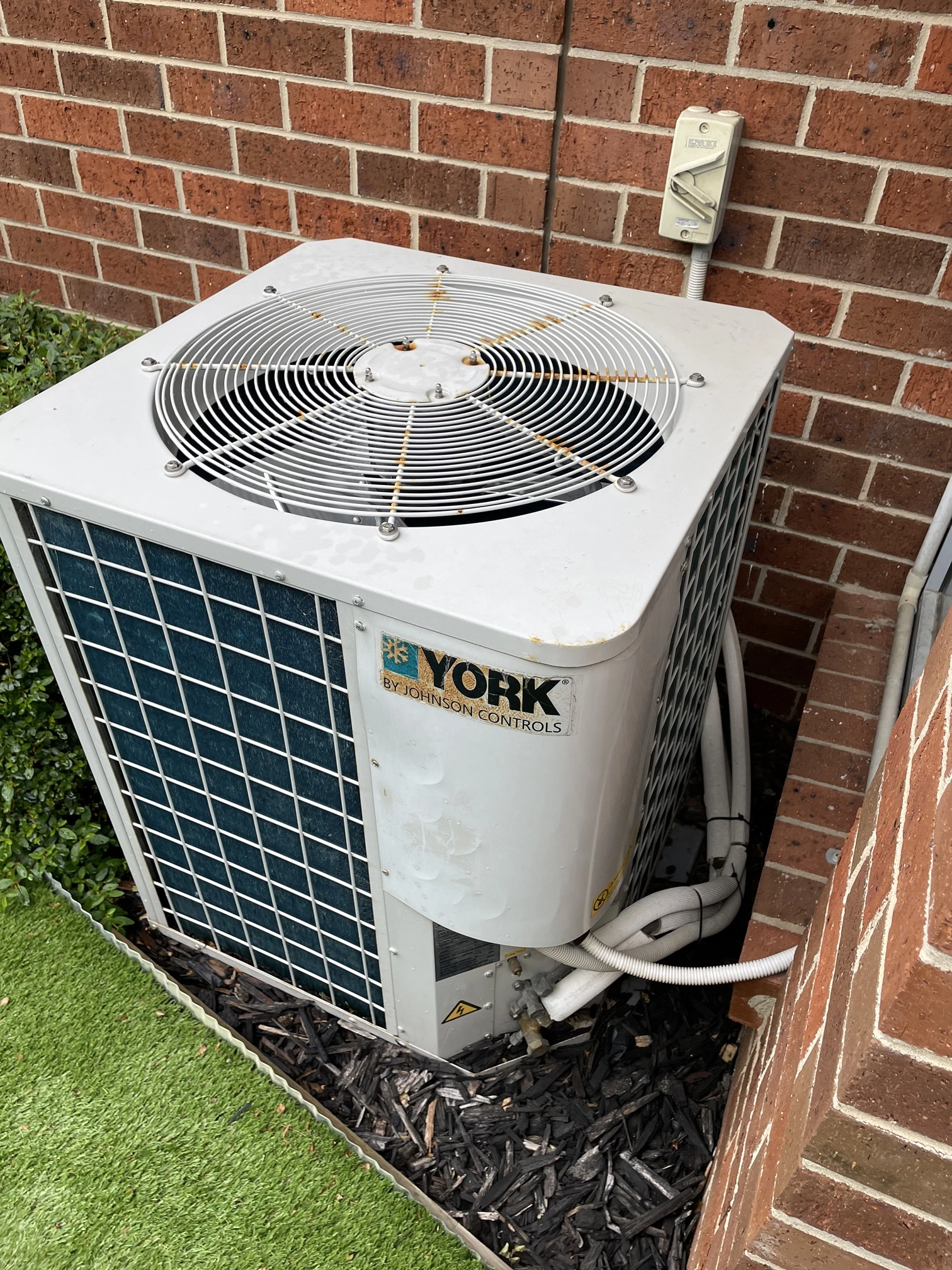
Pros:
- Easy setup for existing ducted heating.
- Becomes a dual-comfort system.
Cons:
- Can only be integrated with gas ducted heating.
- Dedicated cooling systems outperform it.
Ideal use cases:
- Homes with existing gas ducted heating.
| Type | How It Works | Pros | Cons | Ideal Use Cases |
|---|---|---|---|---|
| Ducted Air Conditioning | Supplies heating and cooling via ducts connected to rooms (zones). |
|
|
|
| Split System Air Conditioning | An indoor unit blows cool air into a room, while the outdoor unit extracts heat. |
|
|
|
| Multi Split System | Multiple indoor units distribute cool air to several rooms, using one outdoor unit. |
|
|
|
| Evaporative Cooling | Air travels over water-soaked pads, creating a natural breeze throughout the home. |
|
|
|
| Add-On Cooling | Connects a refrigerated cooling unit to an existing gas ducted heating system. |
|
|
|
Choosing the Right Air Conditioner for Your Home
Now that you’re aware of the different types of air conditioning systems, it’s time to find your dream system tailored to your needs.
These simple characteristics will ensure you don’t miss crucial factors that will affect your home cooling comfort.
Room Size and Cooling Capacity
There are so many things to consider when picking the size of your air con.
- Building materials
- Location
- Space needed to cool.
- Windows
- No. of home residents
And many more.
Aim to get the perfect size for your home.
If you select a unit too small, it won’t be able to sustain quality cooling.
If you select a unit too big, it’ll cost more and waste energy.
When you’ve decided that you want a new air conditioner, we recommend hiring air conditioning experts to properly assess your cooling capacity requirements.
However, we’ll show you how to estimate your air conditioner cooling requirements through basic maths (don’t be scared).
Required AC Capacity (kW) = (Room Volume × Base Factor) + Adjustments
Room volume = Length X Width X Height
x
Base factor = 0.025
+
Adjustments:
+ Add 0.25 kW per window
+ Add 0.15 kW per person
+ For poor insulation: multiply the final result by 1.1
+ For rooms with direct sunlight: multiply the final result by 1.1
+ For kitchens: multiply the final result by 1.5
This will give you a solid estimate to work with.
Estimate the air conditioning size needed for your home through our handy AC size calculator.
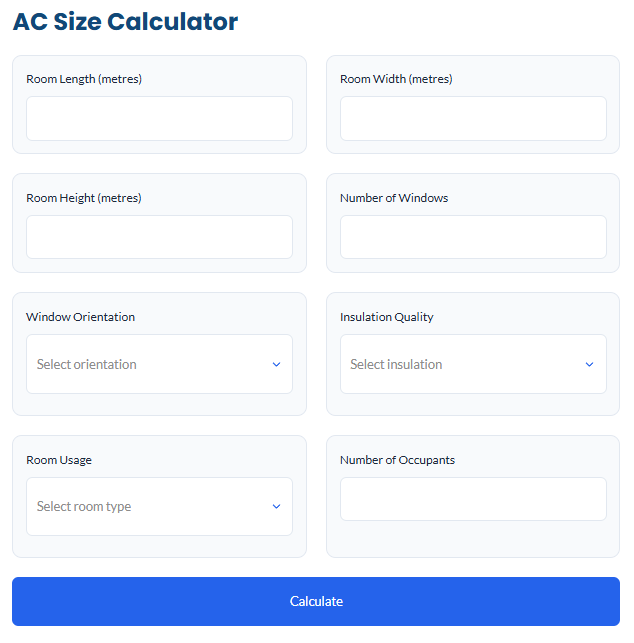
No calculator will replace expert advice from a licenced technician.
Energy-Efficiency and Star Ratings
All air conditioners in Australia have a zoned energy rating label (ZERL) making it easier to choose a more energy-efficient system.
To keep it simple the more stars an air conditioner has, the more energy-efficient it is.
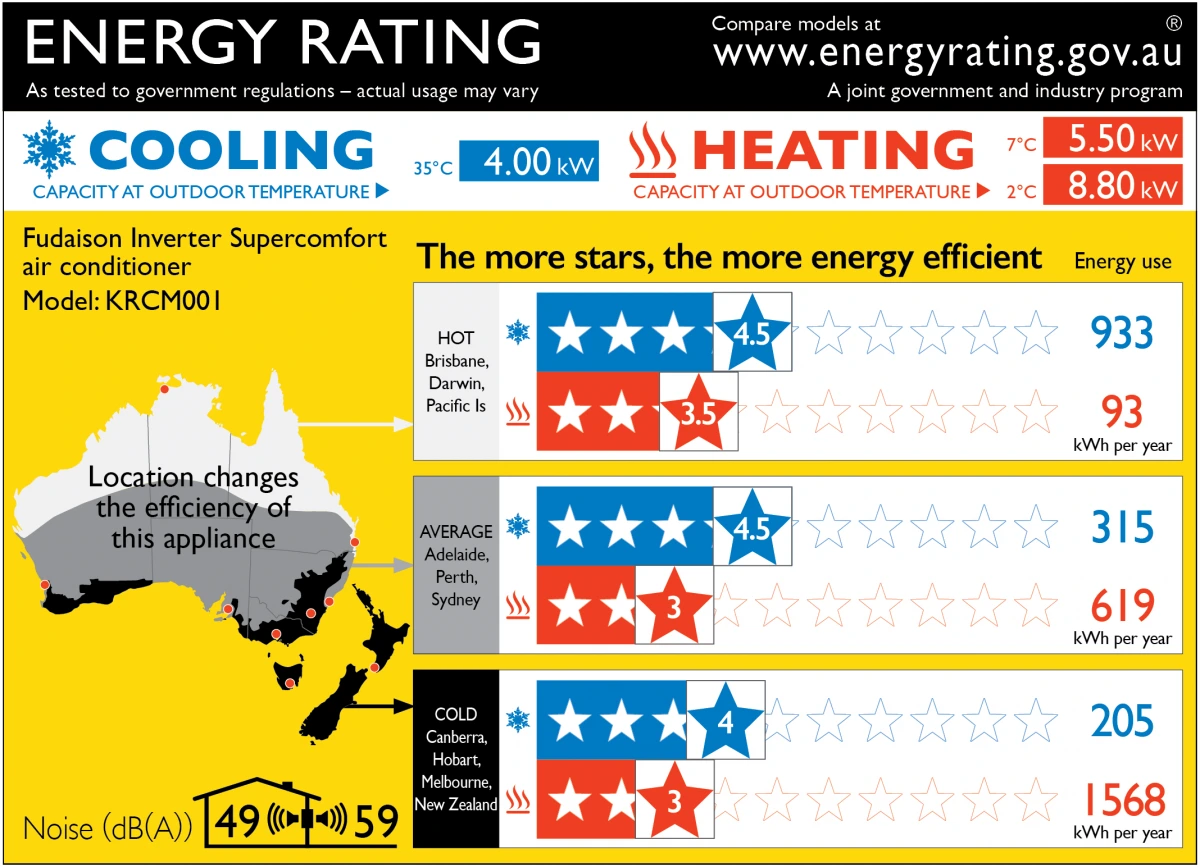
This means you’ll save money on running costs year-on-year.
For Melbourne only pay attention to the section labeled ‘COLD’
Budget and Running Costs
So now you might be asking what the different air conditioning systems cost to install and run.
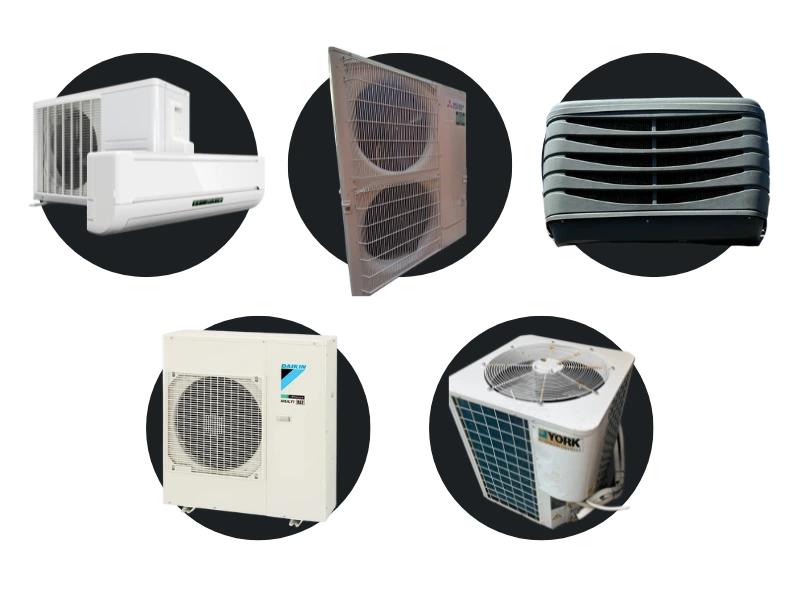
We’ve been in the industry for 100+ years so we know something about air conditioning costs.
Based on our experience here are the costs of different AC systems:
| Type | Installation Costs | Running Costs |
|---|---|---|
| Split System | $1,500 – $3,000 | $0.20 – $0.40 per hour |
| Multi-Head Split System | $2,000 – $11,000 | $0.35 – $0.55 per hour |
| Evaporative Cooling | $2,500 – $5,000 | $0.20 – $0.30 per hour |
| Ducted A/C | $8,000 – $15,000 | $1.00 – $1.50 per hour |
| Window Air Conditioning | $500 – $1,500 | $0.20 – $0.50 per hour |
| Cassette Air Conditioning | $3,000 – $7,000 | $0.30 – $0.70 per hour |
| Add-On Cooling | $3,000 – $6,000 | $0.30 – $0.50 per hour |
Now there are some other considerations to be made.
Costs can change depending on the following factors:
- Brand and size
- Energy-efficiency rating
- Zoning or not
- Usage
When deciding your budget consider whether you want a top brand, high energy efficiency, zoning, and usage to get the most accurate figure to base your purchase on.
Climate Considerations in Melbourne
Don’t work against the weather, work with it by understanding what systems work best for Melbourne’s climate.
Melbourne experiences hot summers that regularly surpass 40 degrees Celsius.
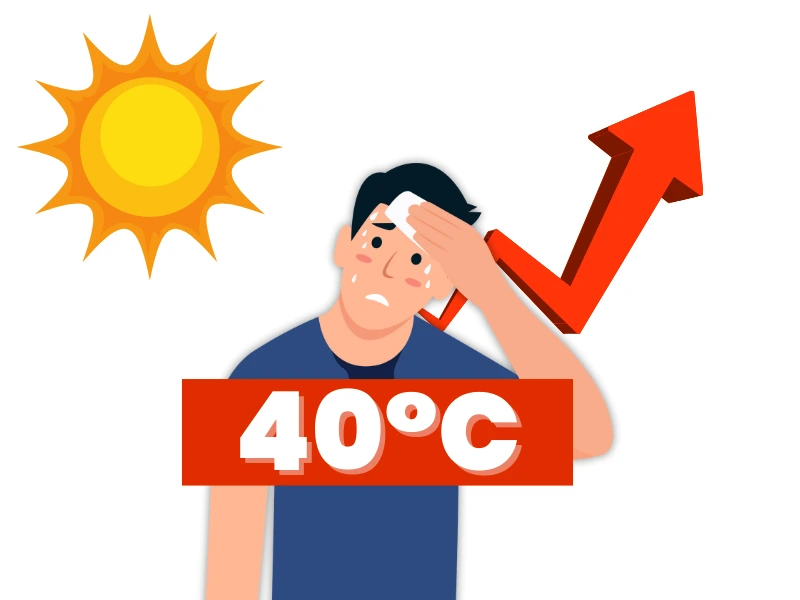
And cold winters that send chills down the spine.
As mentioned earlier you can see 4 seasons in one day, indicating a need for a versatile system that can adapt to whatever comes your way.
A system that can handle both heating and cooling would be necessary to streamline your home climate control without excessive systems.
Systems that can handle hot, cold, and humidity well include split systems and reverse cycle ducted air conditioning.
Most modern air conditioners have dehumidifiers built in.
Although evaporative cooling is not effective during high humidity, it’s still a great cooling-only option.
Melbourne experiences 40-50% humidity which means evaporative coolers are still effective.
Best System for Your Home Type
Each home is unique, so all licenced installers should take into account the climate, room size, budget, energy efficiency, and your needs when deciding which air conditioning system to install.
This is a big financial investment, thus you need to be aware of all the facts beforehand.
Here you can find a guide to the best air conditioning systems for your home type.
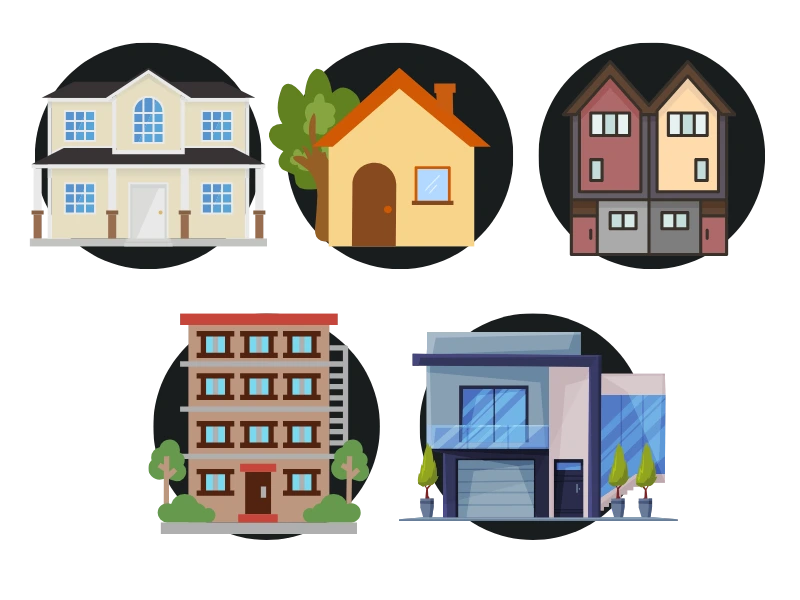
Large home: Reverse cycle ducted air conditioning, Multi-split system
Small home: Split system, evaporative cooling
Apartment/Unit: Split system, portable AC
Townhouse: Multi-split system, ducted AC
What to know about Air Conditioning Installation
You’re set that you need a new air conditioner, but what happens now?
This section will prime you for what to expect from professional installers and how to properly prepare for your new AC.
Why Professional Installation Matters
Professional air conditioning installation involves the handles of chemicals/substances that can be dangerous if handled incorrectly.
A top tip before getting any work done by an air conditioning technician is to confirm they have a full ARC licence (RAC).
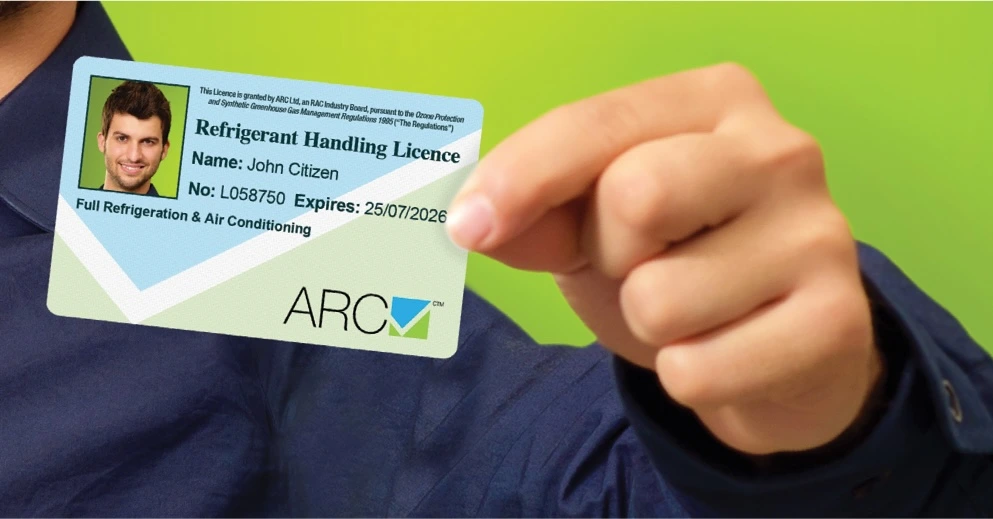
This allows our technicians to work on any refrigeration and air conditioning equipment barring the automotive industry.
This is the highest tier of ARC certification and requires much more training and qualifications than a restricted ARC licence (Splits).
This will only allow the holder to install and decommission split systems and heat pumps.
Often electricians will hold this restricted splits licence meaning they can install a split system but can’t repair or do maintenance on the same system.

We’ve also found that because they undertake less training the installations are rushed, corners are cut, and the quality is worse.
Look for the full ARC licence (RAC) that our technicians possess for higher quality work, better quality air conditioning, and the ability to diagnose and fix future issues if they arise.
What to Expect During Installation
We know it can be overwhelming to have air conditioning professionals in your home, speaking about technical terms that you may not understand.
That’s why our team ensures clarity throughout the whole process through open, clear communication.
A smooth AC installation should include these steps:
Site assessment:
- Room sizes and layout
- Insulation and sun exposure
- Your cooling preferences
- Installation location options
- Electrical requirements
- Budget considerations
System selection:
- Clear system recommendations
- Upfront pricing with no hidden costs
- Energy efficiency ratings explained
- Perfect size for your space
- Installation timeline
- All your questions answered
Our Installation Process:
- Initial setup and area protection
- System positioning and mounting
- Professional electrical work
- Pipe and drainage installation
- System testing and optimisation
- Complete site cleanup
Complete Setup Includes:
- Full system demonstration
- Temperature control guidance
- Maintenance tips
- Operation manual walk-through
- Performance verification
- Warranty documentation
Choosing the Right Placement for Your AC Unit
In order to find the best placement for your air conditioning system, our technicians will use a combination of factors.
Often clients have a desired spot they’d like the air conditioner to go.
Your residential HVAC contractors should try their best to accommodate this unless it isn’t feasible due to airflow issues, heat sources, and other factors.
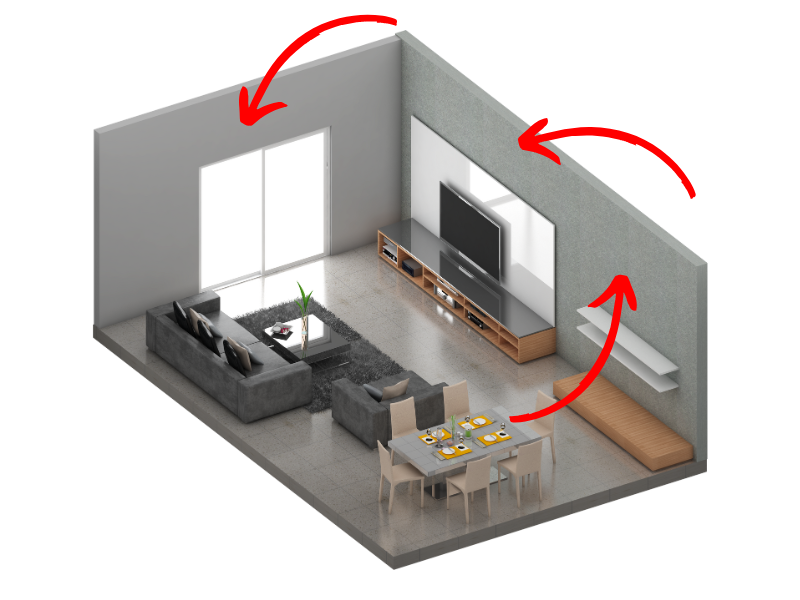
If your contractors have installed over 10,000+ air conditioners like our team, they will use their industry knowledge and experience to determine ideal spots for indoor and outdoor units.
An installation technician should account for these factors:
- Based on the optimal location to cool the space effectively
- Room size & orientation
- Installation requirements
- Client requests
This ensures a quality installation every time.
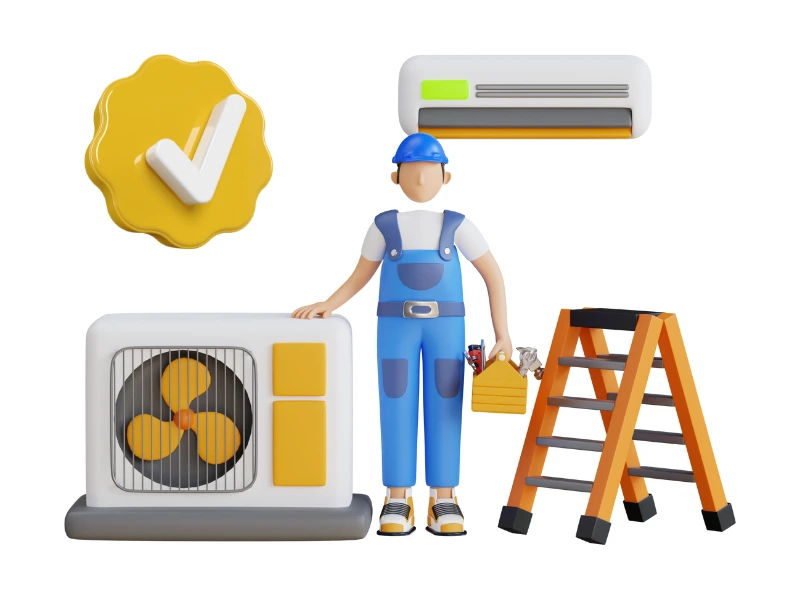
The goal is to have an air conditioner that can cool your space efficiently, and effectively.
Installation Timelines
- Split System air con installation usually takes 4-6 hours, though it may vary based on the system size and complexity.
- Evaporative cooling installations are generally completed within the same day.
- Ducted air conditioning installation usually takes 1-3 days.
- Add-on cooling generally takes 1-2 days.
| Type | Installation Time |
|---|---|
| Split System | 4-6 hours (varies based on system size and complexity) |
| Evaporative Cooling | Generally completed within the same day |
| Ducted Air Conditioning | 1-3 days |
| Add-On Cooling | 1-2 days |
Preparing Your Home for Installation
There are three steps you can take to prepare for an upcoming installation.
Firstly, you’ll want to clear the area of furniture, home decor, or any other obstructions.
This ensures technicians don’t have to spend time moving items around and can go straight to work.
Secondly, you’ll want to remove objects that are blocking the path leading towards the installation site.
Tradies are always going back and forth between areas to grab tools, parts, or moving equipment around.
It’s imperative for safety that they don’t have to worry about knocking objects over and causing injury.
Lastly, if you are unsure about what else needs to be done for your specific installation you can call your contractors and they will kindly advise you.
Quality air conditioning teams will always inform you if anything is required and encourage questions.
Maintenance Tips
Now that your air conditioner is all set up it’s important to understand how to properly maintain your system.
We’ll show you what you can do yourself and what requires professional maintenance.
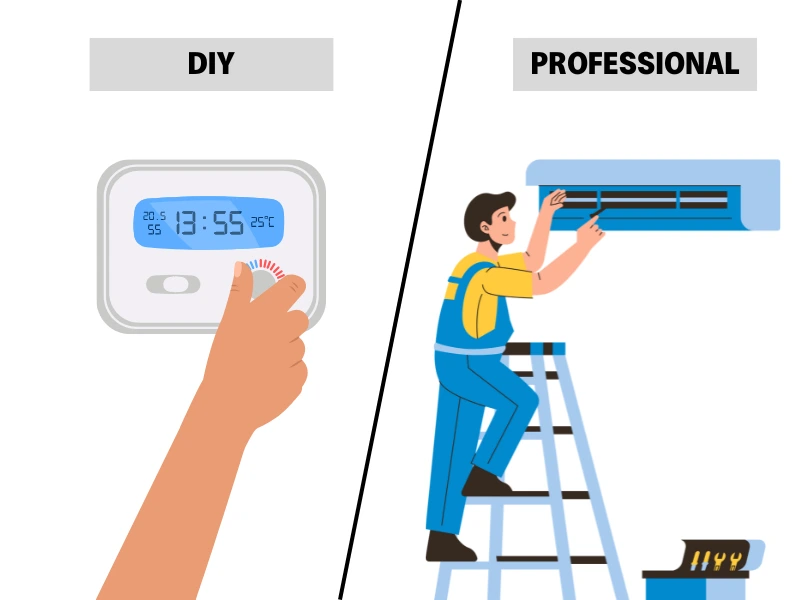
DIY Maintenance Tasks
Any person can do small things to facilitate the optimal function of their unit.
Follow the simple actionable steps to become an air conditioning pro!
Clean filters
Open up the air conditioner and pull out the filters.
Find a clean bench or table to work on.
Grab a brush, rag, and a bucket of water with soap in it.
Use the brush to remove dirt and dust from the filter, use moderate force.
Next, put the filters in the soapy water and use the rag to wipe down the filters.
Once complete, let the filters sit out to dry.
Ensure the filters are completely dry before fitting them back into the air conditioner.
Check the thermostat
If you’re experiencing issues with the temperature, double check the thermostat is set correctly.
Test the functionality of the thermostat by either setting the temperature very low or very high to see if it works as intended.
If it works correctly, switch back to the normal temperature.
If after this it doesn’t work properly you may need to call a professional technician.
Clear debris
Objects and environmental elements can obstruct the airflow of your units.
Make sure leaves and other materials aren’t blocking the unit.
A quick inspection, and subsequent sweep or dust off with a brush is enough to prevent this.
Clean exterior surface of indoor and outdoor units
For this one, you’ll need a little bit of elbow grease and a rag.
Lightly wipe over the outside of your units getting into all the crevices.
If you’re feeling extra clean, you can vacuum around the louvre and air outlet as dust and debris often collect there.
Check for leaks
This simple check can save you a lot of money.
Check around and below the unit for any leaking fluids.
Also, check for fluid on the unit.
If you notice your system is leaking, call a professional to service your air conditioner.
Annual Professional Servicing
Whilst you can do some maintenance tasks yourself, professional service ensures optimal functionality and health long term.
A regular person doesn’t have the qualifications to work on an air conditioner.
Only a professional can identify and repair issues that arise, making sure that your AC lasts many years.
Complete air conditioning inspection
HVAC technicians conduct an extensive inspection of your system.
This includes:
- Checking every component
- Checking refrigerant/gas level
- Checking filters
- Checking electrical components
- Checking compressor function
- Checking the indoor and outdoor fans
- Checking for faulty parts
Clean or replace parts
The system will be tested to identify unusual behaviour.
If something doesn’t work as intended, then the problem will be isolated to find the cause.
Once the part is identified we will replace the part to ensure that a larger problem doesn’t occur.
Parts can degrade over time.
Left to their own devices this can potentially lead to a major part failure in the future.
Air con performance testing
Once the part has been replaced we’ll conduct a full performance test to make sure that your system operates as it should.
Your system may seemingly function normally, but could have an underlying issue that is a disaster waiting to happen.
Treat your air conditioner like your car. There may not be a problem with your car, yet you still take it once or twice a year to get serviced.
This preventative approach ensures your air conditioner lasts 15 + years.
Common Air Conditioning Problems & How To Fix Them
This section will cover all the issues that are common in Melbourne and whether they are minor or major.
As mentioned in the previous section, some issues are a simple fix, while others require a visit from a certified technician.
Air Conditioner Not Cooling Properly
This issue is ubiquitous across Melbourne.
If your system is struggling to cool, the filters and/or coils could be blocked or clogged.
Low refrigerant levels are another culprit we often see.

We also notice that thermostats can sometimes be faulty or just improperly used.
This could be caused by:
- Low refrigerant levels
- Dirty filters or coils
- Faulty thermostats
Fix:
Sometimes this issue can be easy to fix on your own, other times it requires technical expertise.
To attempt to fix the issue, visibly inspect your filters for dust and debris and use the method discussed earlier to clean them.
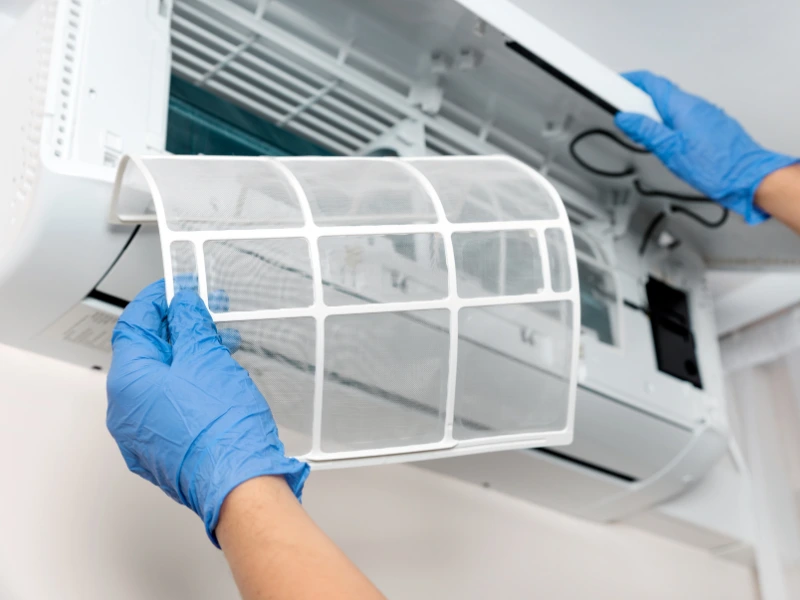
Then make sure you have properly set the correct temperature and setting.
Do not handle or check refrigerants.
If these don’t fix the issue then it probably indicates there is a refrigerant leak which needs to be handled by a licenced professional.
Refrigerants can’t be “topped up”. If refrigerant is low it means that there is a leak, requiring a leak detection and repair.
Australian codes of practice prohibit ‘topping up’ (adding) refrigerant to conditioning/refrigeration systems before checking for, and fixing, any leaks.
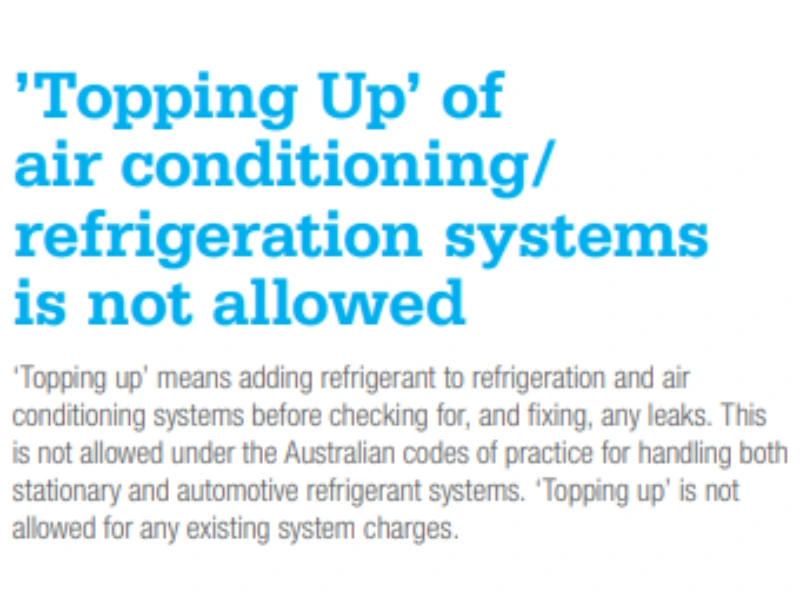
Strange Noises or Smells
Banging, screeching, whistling, and any other noises often indicate a loose part or mechanical issue.
We recommend calling a certified air conditioning expert to assess the issue.
There are several different smells:
- Gas or burning smell
A burning smell coming from your air conditioner could indicate that there is a gas leak or components overheating and burning. Turn off your system and call a professional to handle it.
- Rotten Smell
Rotten egg smells can sometimes be gas leaks such as carbon monoxide. We also get dead animals in ductwork that emit these smells.
- Mouldy Smell
A moldy smell can indicate a dirty condensate tray. Mould accumulates in the drainage causing bacteria, mould, and other nasties to fester.
- Chemical Smell
Chemical and/or coolant smells are often refrigerant leaks.
If you are unsure about any smells, call a registered HVAC professional to diagnose and repair your AC.
High Energy Bills
Higher energy bills may not indicate a problem with your air conditioner.
Before checking other things, assess whether you have been using your system more frequently.
If usage has gone up during a hot period, then this is most likely the cause of the spike in your bill.
If you haven’t been using the system more frequently, we’ve noticed that higher energy bills can be due to compressors or fans working poorly.
Ask yourself how long have you had your system.
If you are regularly getting issues, or if the system is not working optimally for extended periods, consider replacing the AC.
Use this graphic to help determine whether your system needs repair or replacing.
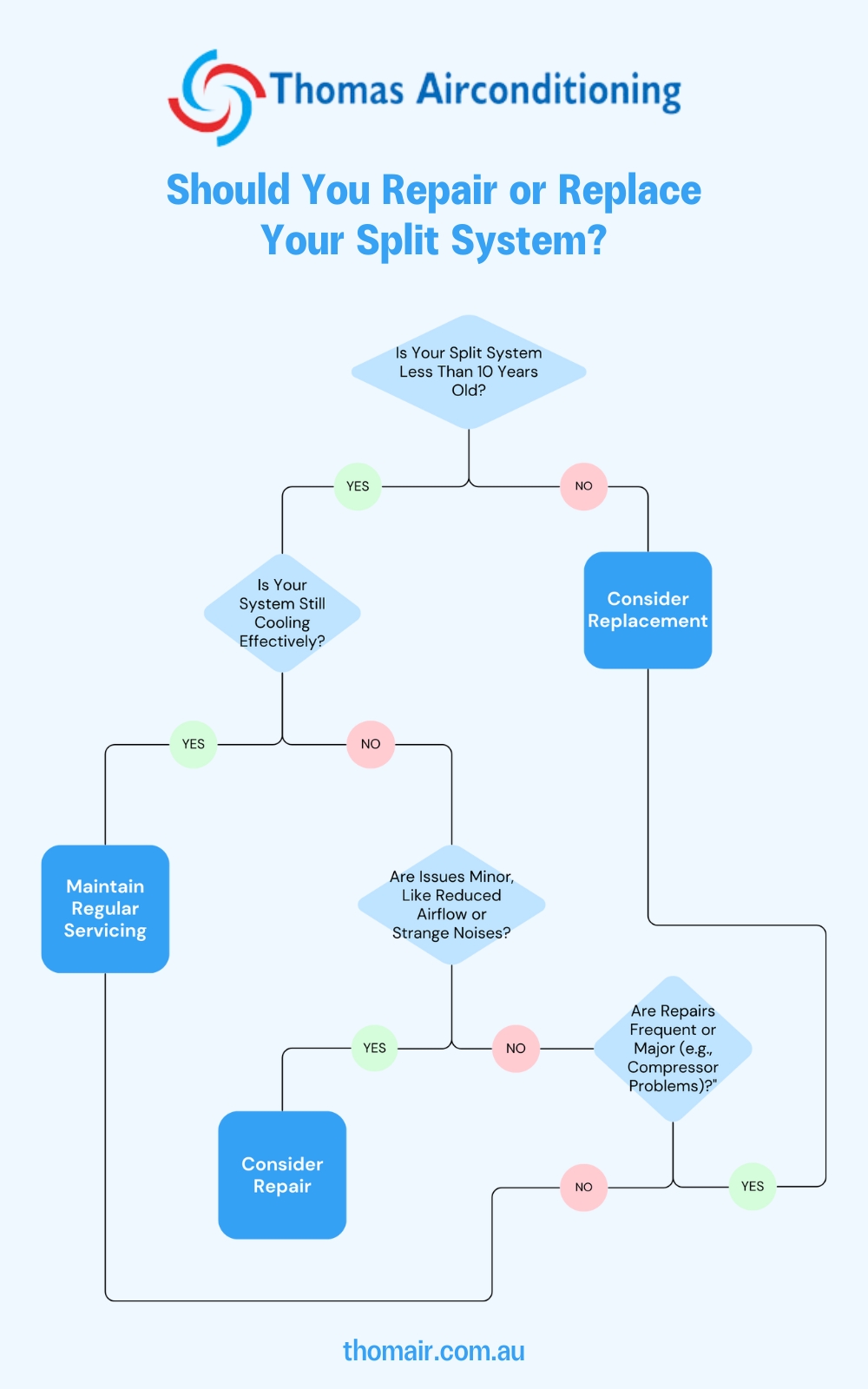
In all cases, contact a team of air conditioning professionals to help assess your AC.
Water Leaks or Ice Build-Up
Water leaks are often minor issues.
A blocked drain or faulty pump usually causes water to leak.
If the condensate tray is clogged it won’t allow water to drain properly, causing a leak.
Similarly, if you have a faulty pump, water will build up and not drain as necessary.
Whilst you could try and unblock the drain tray, we don’t recommend it may be a larger issue.
With regards to ice build-up, this can occur due to many things.
This could be a faulty blower fan, dirty coils/filters, or a refrigerant leak.
The only step you can take to fix this issue is to clean the filters and coils as mentioned earlier.
If this doesn’t fix the issue and ice continues to build up, reach out to a local air conditioning team in Melbourne for assessment.
AC Won’t Turn On
If your AC doesn’t turn on check the switchboard to see if the circuit has been tripped.
It could just be a small electrical issue to a large problem like a broken compressor.
If it is the latter it’s often more cost effective to replace rather than repair.
Energy Efficiency and Cost-Saving Tips
In this chapter, we’ll discuss energy savings tips and recommendations.
These are simple steps to improve the energy efficiency of your AC.
Implement these to see lower bills.
Optimal Thermostat Settings
Everyone wants to know the perfect setting to maximise comfort and energy efficiency.
We’ll keep it simple for you.
Our technicians have recommended these settings:
Summer: 22-24 degrees Celsius
Winter: 20-21 degrees Celsius
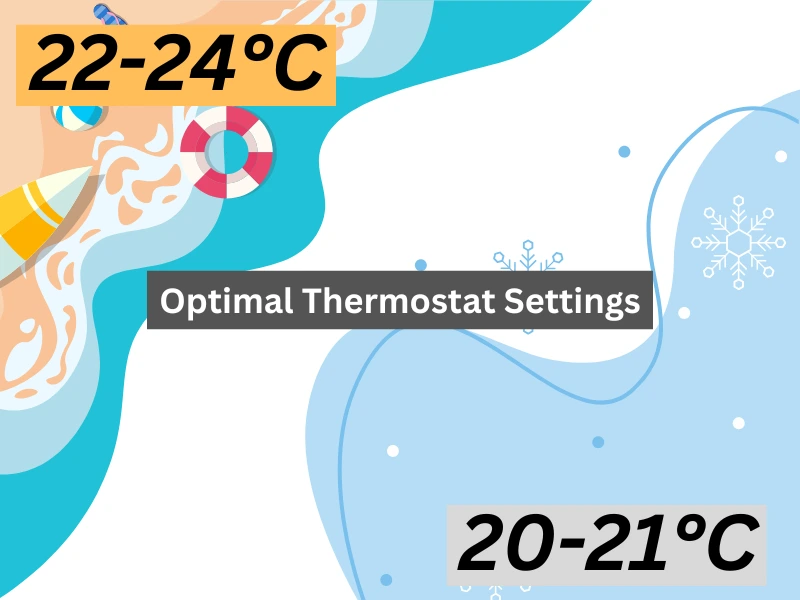
These are also in line with recommendations made by Canstar blue.
Using Fans with Your AC
Using fans with air conditioning can help improve the airflow within your home.
It allows the air to disperse evenly throughout the space maximising comfort levels.
Air conditioning can take time to work its cooling magic, thus having a ceiling fan can get the whole space cool quicker.
The cool breeze can make the air conditioning feel colder than it actually is, which means that you don’t have to blast the AC.
Sealing Doors and Windows
You’re in luck if you live in Melbourne, as windows, doors, chimneys, and vents can be sealed for free under the Victorian Energy Upgrades (VEU) program.
This initiative is in place to help Victorians lower energy bills and energy consumption.
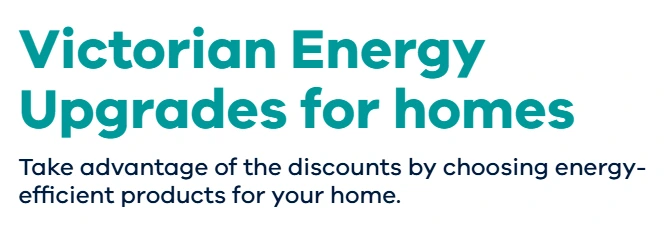
According to Energy Makeovers, installing 2 fans and door seals will save approximately $14/month which is $168 a year.
What a deal!
All you need to do is complete the installation with an accredited provider.
You can always seal your doors and windows yourself.
Here you can learn which door seals to buy.
Regular Maintenance to Improve Efficiency
Annual air conditioning maintenance is the best way to improve and ensure efficiency long term.
Here’s why:
- Technicians find issues and faults causing inefficient operation.
- Cleaning and testing of parts uncovering wear and tear.
- Professional recommendations about the health of the system.
If you don’t change the oil in your car, you are running the risk that your car experiences a catastrophic issue.
Been there and done that, it’s not fun and is quite costly.
Professional service is a small cost to prevent a large cost whilst maximising efficiency and bringing down your energy costs.
Government Rebates for Energy-Efficient Systems
As part of the Victorian Energy Upgrades for homes, you receive rebates or discounts on air conditioning equipment that helps save energy.
The main rebate is for installing highly efficient air conditioners.
You can find every model of electric air conditioner eligible under the scheme.
Select “6(23) – Space heater and cooler – High efficiency air conditioner” under product to see all products.
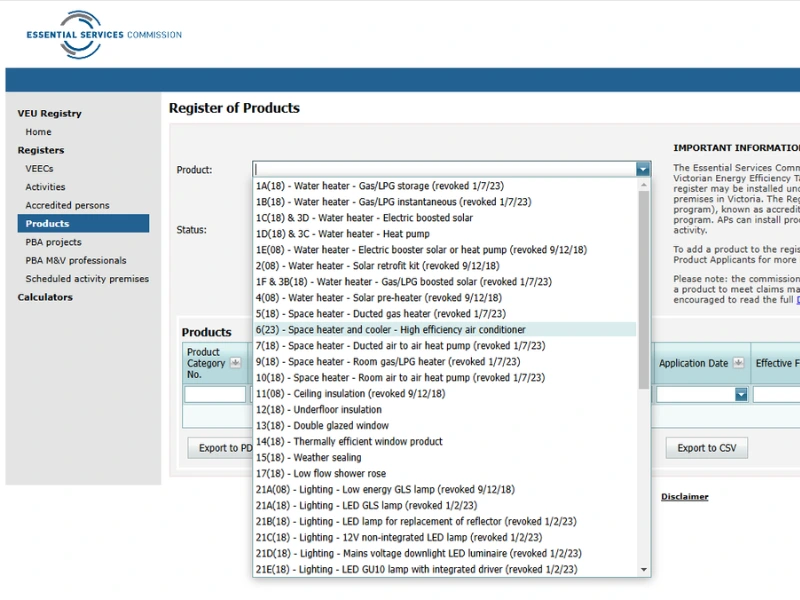
There are two ways to receive the discount:
Option 1: Accredited Provider installation
- Choose the eligible upgrade listed with Essential Services Commission.
- The VEU accredited provider provides an upfront discount to you.
- The VEU accredited provider completes the installation of an approved product.
Option 2: Choose your own installer
- Choose the eligible upgrade listed with Essential Services Commission.
- Hire a qualified tradesperson partnered with an accredited provider to handle the paperwork and secure your discount.
- Choose an eligible product.
Your qualified tradesperson:
- provides a quote including the discount
- completes the installation of an approved product
- returns completed forms to the accredited provider to process the discount.
Whilst there is an upfront cost that is discounted the amount of savings is well worth it long term.
Speak to a qualified HVAC team in Melbourne that participates in the scheme.
Air Conditioning Brands Recommended for Melbourne
This section is all about informing you of the relevant air conditioning brands and models that are high quality.
We’ll go through top brands, energy efficiency, budget-friendly options, and more.
Top Energy-Efficient Brands
With various brands popular in Melbourne, Australia, however, these 3 brands stick out amongst the pack.
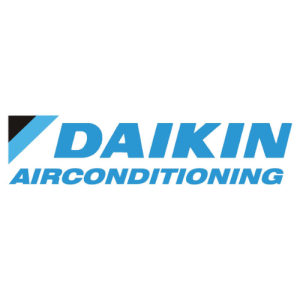
As one of the premier air conditioning brands in Australia. Daikin continuously makes leading air conditioners.
They currently have 6 types of ducted air conditioning systems:
- Premium Inverter Ducted
- Inverter Ducted
- Slimline Ducted
- Bulkhead System
- Premium Inverter Underfloor Ducted
- Inverter Underfloor Ducted

Epitomising Japanese quality, Mitsubishi Electric has a remarkable reputation for excellence and energy efficiency.
They currently have 5 types of ducted air conditioning systems:
- PEAD-M-JAAD Series
- PEA-M-GAA Series
- PEA-M-HAA Series
- PEA-M160HAA
- PEA-M-LAA Series

With a long history in Australia, Fujitsu has proven to be a quality air conditioning manufacturer.
They currently have 5 types of ducted air conditioning systems:
- Bulkhead
- Slimline
- Infinity
- Single Phase
- Three Phase
Best Reverse Cycle Air Conditioners
All these options provide whole-home heating and cooling.
Daikin Premium Inverter Ducted Air Conditioner

- Remarkable energy performance
- Available capacities: 7.1kW, 8.5kW, 10.0kW, 12.5kW, 14.0kW, 16.0kW, 18.0kW, 20.0kW, 24.0kW
Daikin Slimline Ducted Air Conditioner

- Suited to limited ceiling space
- Available capacities: 5.0kW, 6.0kW, 7.1kW, 8.5kW, 10.0kW, 12.5kW, 14.0kW
Mitsubishi Electric PEAD-M-JAAD Series Ducted Air Conditioner

- Exceptional efficiency
- Low-profile design
- Capacity Range: 5.0 kW – 14.0 kW
Mitsubishi Electric PEA-M-GAA Series Ducted Air Conditioner

- Flexibility in design
- High external static pressure up to 150 Pa
- Capacity Range: 10.0 kW – 14.0 kW
Fujitsu Slimline Ducted Air Conditioner
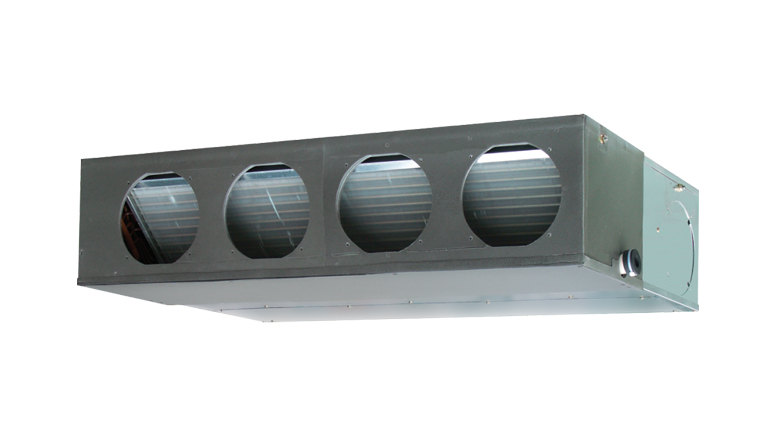
- Slim and compact design perfect for discreet installation
- Capacities available: 7.1kW, 8.5kW, 10.0kW, 11.5kW
Fujitsu High Static Single Phase Ducted Air Conditioner
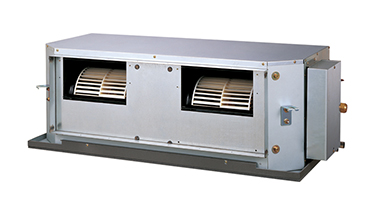
- High static allows for more air ducts
- Single phase means greater installation flexibility
- Capacities available: 9.0kW, 10.5kW, 12.5kW, 14.0kW
Durability and Warranty Considerations
Daikin, Mitsubishi Electric, and Fujitsu all have a 5-year labour and parts warranty.
A big reason why these air conditioning brands are the best is because they have great support and warranty.
Budget-Friendly Options
Whilst we always recommend the top brands because they have the best value for money.
Some brands are cheaper and offer decent energy efficiency.

- Energy-saving motion sensor and eco-operation
- Industry-leading energy efficiency
Kaden
KSI Split System Air Conditioner

- Smart Wi-Fi Control
- High-efficiency operation
- Leading health features
Carrier
Inverter hi-wall split system – indigo
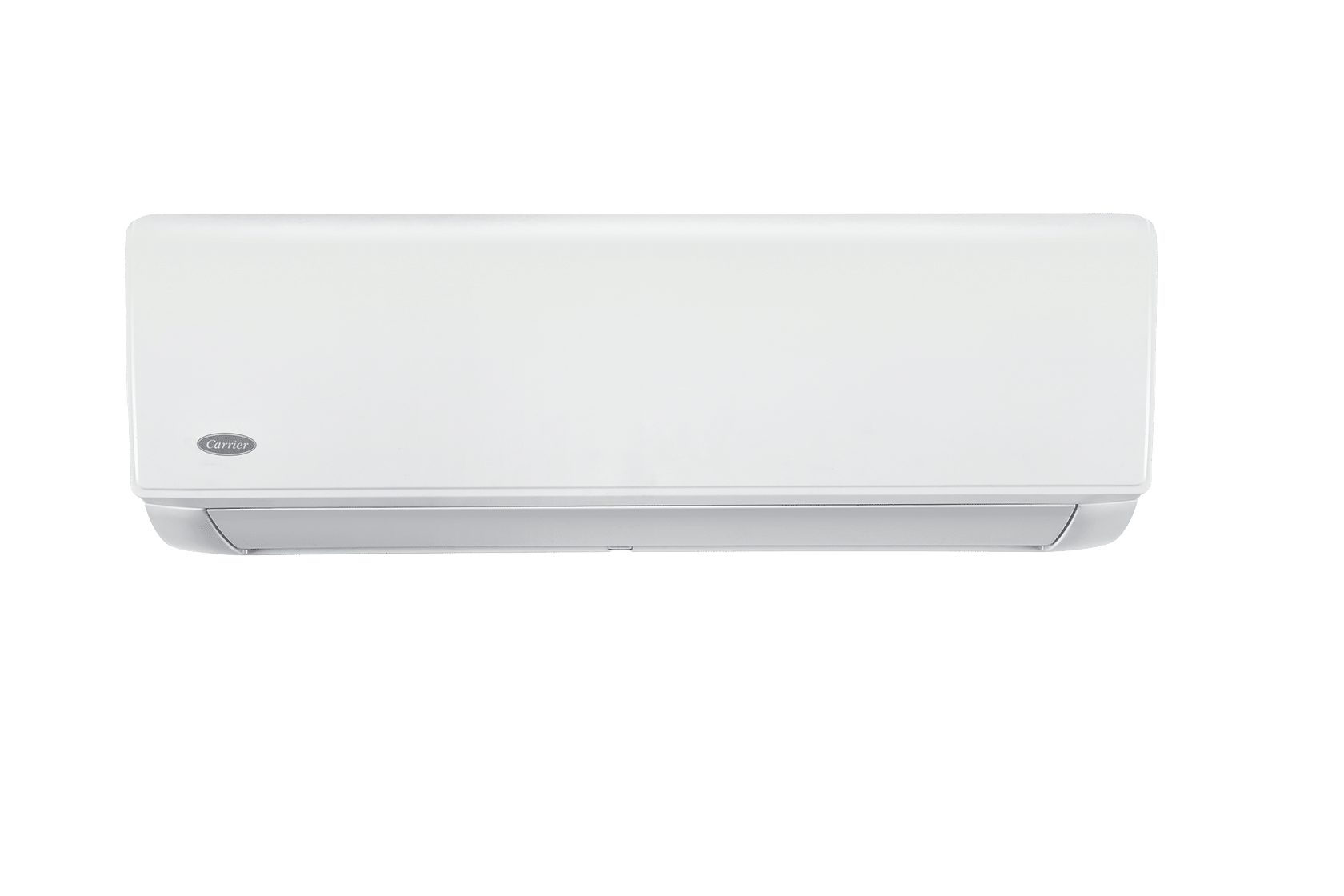
- 6.5 Star energy efficiency for the 2.6kW model (popular for bedrooms, study, guest rooms)
- Active energy control
Rinnai
Ducted Reverse Cycle Air Conditioning (R32)

- 8 zones
- WI-FI & Remote access
Smart Features and Technology
It’s entirely up to you whether or not you want integration with smart home ecosystems.
Most modern air conditioners have catered to the smart features trend.
This feature is one of the most convenient, allowing you to control your air conditioner from anywhere.
These usually come as an add-on with a smartphone app and the ability to be linked to your voice operation.
Daikin has the airbase app, Mitsubishi Electric has the Wi-Fi Control App, and Fujitsu has the myanywAiR® Next app.
Here are some of the most common features and technology available:
- Smart home integration
- Smart thermostats
- Wi-Fi Control
- Advanced sensors for climate
- Auto-adjustment to user preferences

